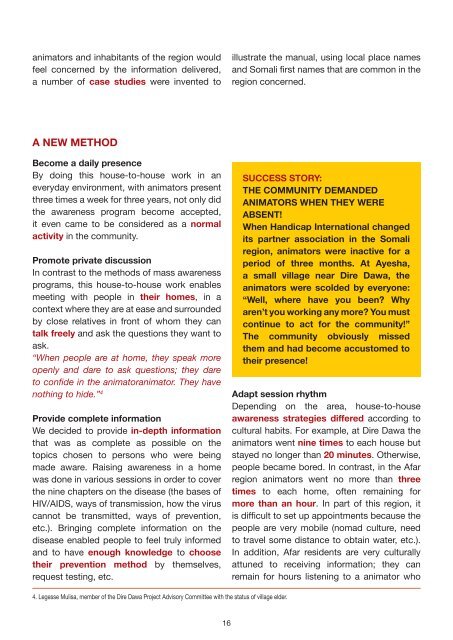Anchoring Awareness in the Community - Handicap International
Anchoring Awareness in the Community - Handicap International
Anchoring Awareness in the Community - Handicap International
You also want an ePaper? Increase the reach of your titles
YUMPU automatically turns print PDFs into web optimized ePapers that Google loves.
animators and <strong>in</strong>habitants of <strong>the</strong> region would<br />
feel concerned by <strong>the</strong> <strong>in</strong>formation delivered,<br />
a number of case studies were <strong>in</strong>vented to<br />
illustrate <strong>the</strong> manual, us<strong>in</strong>g local place names<br />
and Somali first names that are common <strong>in</strong> <strong>the</strong><br />
region concerned.<br />
A NEW METHOD<br />
Become a daily presence<br />
By do<strong>in</strong>g this house-to-house work <strong>in</strong> an<br />
everyday environment, with animators present<br />
three times a week for three years, not only did<br />
<strong>the</strong> awareness program become accepted,<br />
it even came to be considered as a normal<br />
activity <strong>in</strong> <strong>the</strong> community.<br />
Promote private discussion<br />
In contrast to <strong>the</strong> methods of mass awareness<br />
programs, this house-to-house work enables<br />
meet<strong>in</strong>g with people <strong>in</strong> <strong>the</strong>ir homes, <strong>in</strong> a<br />
context where <strong>the</strong>y are at ease and surrounded<br />
by close relatives <strong>in</strong> front of whom <strong>the</strong>y can<br />
talk freely and ask <strong>the</strong> questions <strong>the</strong>y want to<br />
ask.<br />
“When people are at home, <strong>the</strong>y speak more<br />
openly and dare to ask questions; <strong>the</strong>y dare<br />
to confide <strong>in</strong> <strong>the</strong> animatoranimator. They have<br />
noth<strong>in</strong>g to hide.” 4<br />
Provide complete <strong>in</strong>formation<br />
We decided to provide <strong>in</strong>-depth <strong>in</strong>formation<br />
that was as complete as possible on <strong>the</strong><br />
topics chosen to persons who were be<strong>in</strong>g<br />
made aware. Rais<strong>in</strong>g awareness <strong>in</strong> a home<br />
was done <strong>in</strong> various sessions <strong>in</strong> order to cover<br />
<strong>the</strong> n<strong>in</strong>e chapters on <strong>the</strong> disease (<strong>the</strong> bases of<br />
HIV/AIDS, ways of transmission, how <strong>the</strong> virus<br />
cannot be transmitted, ways of prevention,<br />
etc.). Br<strong>in</strong>g<strong>in</strong>g complete <strong>in</strong>formation on <strong>the</strong><br />
disease enabled people to feel truly <strong>in</strong>formed<br />
and to have enough knowledge to choose<br />
<strong>the</strong>ir prevention method by <strong>the</strong>mselves,<br />
request test<strong>in</strong>g, etc.<br />
SUCCESS STORY:<br />
THE COMMUNITY DEMANDED<br />
ANIMATORS WHEN THEY WERE<br />
ABSENT!<br />
When <strong>Handicap</strong> <strong>International</strong> changed<br />
its partner association <strong>in</strong> <strong>the</strong> Somali<br />
region, animators were <strong>in</strong>active for a<br />
period of three months. At Ayesha,<br />
a small village near Dire Dawa, <strong>the</strong><br />
animators were scolded by everyone:<br />
“Well, where have you been? Why<br />
aren’t you work<strong>in</strong>g any more? You must<br />
cont<strong>in</strong>ue to act for <strong>the</strong> community!”<br />
The community obviously missed<br />
<strong>the</strong>m and had become accustomed to<br />
<strong>the</strong>ir presence!<br />
Adapt session rhythm<br />
Depend<strong>in</strong>g on <strong>the</strong> area, house-to-house<br />
awareness strategies differed accord<strong>in</strong>g to<br />
cultural habits. For example, at Dire Dawa <strong>the</strong><br />
animators went n<strong>in</strong>e times to each house but<br />
stayed no longer than 20 m<strong>in</strong>utes. O<strong>the</strong>rwise,<br />
people became bored. In contrast, <strong>in</strong> <strong>the</strong> Afar<br />
region animators went no more than three<br />
times to each home, often rema<strong>in</strong><strong>in</strong>g for<br />
more than an hour. In part of this region, it<br />
is difficult to set up appo<strong>in</strong>tments because <strong>the</strong><br />
people are very mobile (nomad culture, need<br />
to travel some distance to obta<strong>in</strong> water, etc.).<br />
In addition, Afar residents are very culturally<br />
attuned to receiv<strong>in</strong>g <strong>in</strong>formation; <strong>the</strong>y can<br />
rema<strong>in</strong> for hours listen<strong>in</strong>g to a animator who<br />
4. Legesse Mulisa, member of <strong>the</strong> Dire Dawa Project Advisory Committee with <strong>the</strong> status of village elder.<br />
16

















